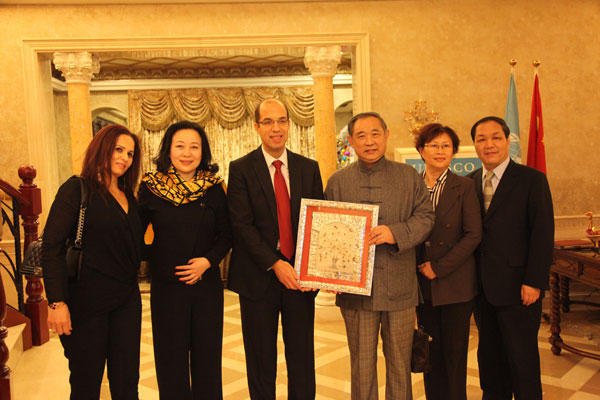
On Feb.1st, 2016, the Preliminary Eve ofthe Chinese Spring Festival, the families of Tunisian Ambassador H.E. Mr. TarekAmri, Mr. Li Ruohong, Chairman of Board of Directors of Beijing InternationalPeace Culture Foundation (BJIPCF) and Mr. Li Honghai, Director of BJIPCFgathered at Peace Garden Museum just like what family members do.
In a festival atmosphere, Mr. Li Ruohongintroduced to Mr. And Mrs. Amri Chinese traditions and customs and exchangedwith them ideas on the comparison of cultures of China, Japan, Tunisia andEurope. During the dinner, Mr. Amri expressed his profound love for Chinesecosine: ”As an Ambassador, a general knowledge of local cosines, living style,customs and traditions, art and culture, etc.of the country to which I’ve beenappointed is indispensable and that’s just what I’m interested in.” Besides agastronome, Mr. Tarek is also a fan of cooking. Mrs. Tarek, an artist, also aprofessional of ikebana, showed great willingness to co-host cultural programswith Peace Garden Museum. Mr. And Mrs. Tarek’s love for life inspired all thepeople present.
Mr. Tarek explained the investmentpreferences and trading mentalities of Tunisian entrepreneurs. He also acceptedthe initiative of the establishment of an association for China-Tunisiafriendship and promised to invite representative enterprises to join theassociation. Besides, Mr. Tarek, who used to serve as the deputy chief ofmission to Japan, shared with Mr. Li Honghai the experiences in Japan.
Mr. Li Ruohong highly appraised NationalDialogue Quartet of Tunisia-the 2015 Nobel Peace Price Winner and Mr. Tarekexpressed his enthusiasm to be a part of the peace cause pursued by BJIPCF.

- Peace Garden held Diplomatic Envoys’ National Day&Mid-Autumn Festival Poetry&Music Gala
- Li Ruohong attended the 61st anniversary celebration of Malta's Independence Day
- The 12th Peace Garden Peace Festival, in collaboration with the Silk Road, jointly builds a garden of peace
- Li Ruohong attended the 1st Pakistan Mango Festival
- Li Ruohong and the visiting Turkmenistan Ambassador discuss Peace&Development issues of international concern
- Li Ruohong delivered a speech and signed amendment at the UNESCO Silk Road Dialogue Conference
- Celebrating the 59th Anniversary of Guyana's Independence and Promoting International Exchange and Cooperation
- Peace Garden held Silk Road Latin American and Caribbean International Community event
- Li Ruohong and Belgian Ambassador to China established Peace Garden Diplomatic Club
- Li Ruohong met with Ambassador of Lesotho to explore new opportunities for international cooperation
“一带一路”文化互动版图:音乐与艺术 | 科学技术与技能 | 医术与医药 | 服装与服饰 | 美食与农业 | 神话与幻想 | 传统竞技与体育 | 语言与文学 | 仪式与庆典 | 宗教与精神
An Interactive Atlas of Cultural Interactions along the Silk Roads: Arts and Music | Seience,Technology and Know-how | Pharmacology and Medicine | Costumes and Clothing | Food and Agriculture | Mythology and Fantasy | Traditional Games and Sports | Languages and literature | Rituals and Celebrations | Religion and Spitituality


